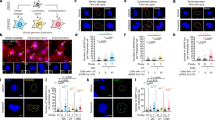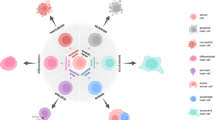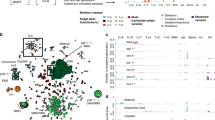Abstract
A major dogma in cancer research is that cancer begins at the cellular level. Because of this single-cell origin, evolutionary principles have often been used to explain how somatic cancer cells are selected at a sub-individual level. The traditional application of Darwinian theory, however, in which the colony of cells constituting an individual is regarded as a whole, has not been applied extensively to the understanding of cancer until recently. Two proponents for this view, Breivik and Gaudernack, have suggested that in certain situations the cost of DNA repair might exceed the cost of errors. This model predicts that genetic stability is configured for an optimal cost-benefit relationship. Natural selection is not expected to have produced the best genetic stability available in the human body, merely the best compromise of DNA repair and costs. Repair and maintenance of the vast human genome is thermodynamically expensive, and an optimal balance between DNA repair and dietary needs is likely to have originated. Furthermore, fast growth conveys significant advantages such as early maturation or cognitive development, but usually at the expense of replication accuracy. Thus, a compromise between growth speed and cancer risk is likely to have taken place. These and other ecological mechanisms have probably prevented genomic stability to reach its full potential in the human body. In contrast, germ lines express near perfect DNA maintenance. Although germ cells are specialized DNA-conserving cells with few other functions, it's not given that their proteins will all be incompatible with the somatic cell. One approach to study this would be to systematically explore which DNA-stability and -repair systems are unique in germ cells, and induce their expression in invertebrate and mammalian model organisms. This could unveil which DNA-repair systems are switched off in the somatic cell lines, as they are incompatible, and which are absent due to evolution. The present review discuss different DNA-repair systems and cell cycle check point control mechanisms shown to be different or unique in the germ cell, and how they may be utilized in cancer therapy.
This is a preview of subscription content, access via your institution
Access options
Subscribe to this journal
Receive 12 print issues and online access
$259.00 per year
only $21.58 per issue
Buy this article
- Purchase on Springer Link
- Instant access to full article PDF
Prices may be subject to local taxes which are calculated during checkout

Similar content being viewed by others
References
Breivik J, Gaudernack G . Genomic instability, DNA methylation, and natural selection in colorectal carcinogenesis. Semin Cancer Biol 1999; 9: 245–254.
Breivik J, Gaudernack G . Resolving the evolutionary paradox of genetic instability: a cost-benefit analysis of DNA repair in changing environments. FEBS Lett 2004; 563: 7–12.
Breivik J . The evolutionary origin of genetic instability in cancer development. Semin Cancer Biol 2005; 15: 51–60.
Baarends WM, van der Laan R, Grootegoed JA . DNA repair mechanisms and gametogenesis. Reproduction 2001; 121: 31–39.
Nybo Andersen AM, Hansen KD, Andersen PK, Davey Smith G . Advanced paternal age and risk of fetal death: a cohort study. Am J Epidemiol 2004; 160: 1214–1222.
Ozturk S, Demir N . DNA repair mechanisms in mammalian germ cells. Histol Histopathol 2011; 26: 505–517.
Jaroudi S, Kakourou G, Cawood S, Doshi A, Ranieri DM, Serhal P et al. Expression profiling of DNA repair genes in human oocytes and blastocysts using microarrays. Hum Reprod 2009; 24: 2649–2655.
Menezo Jr Y, Russo G, Tosti E, El Mouatassim S, Benkhalifa M . Expression profile of genes coding for DNA repair in human oocytes using pangenomic microarrays, with a special focus on ROS linked decays. J Assist Reprod Genet 2007; 24: 513–520.
Wells D, Bermudez MG, Steuerwald N, Thornhill AR, Walker DL, Malter H et al. Expression of genes regulating chromosome segregation, the cell cycle and apoptosis during human preimplantation development. Hum Reprod 2005; 20: 1339–1348.
Intano GW, McMahan CA, Walter RB, McCarrey JR, Walter CA . Mixed spermatogenic germ cell nuclear extracts exhibit high base excision repair activity. Nucleic Acids Res 2001; 29: 1366–1372.
Cherney BW, McBride OW, Chen DF, Alkhatib H, Bhatia K, Hensley P et al. cDNA sequence, protein structure, and chromosomal location of the human gene for poly(ADP-ribose) polymerase. Proc Natl Acad Sci USA 1987; 84: 8370–8374.
Christmann M, Tomicic MT, Roos WP, Kaina B . Mechanisms of human DNA repair: an update. Toxicology 2003; 193: 3–34.
Mayer-Kuckuk P, Ullrich O, Ziegler M, Grune T, Schweiger M . Functional interaction of poly(ADP-ribose) with the 20S proteasome in vitro. Biochem Biophys Res Commun 1999; 259: 576–581.
Franca LR, Ogawa T, Avarbock MR, Brinster RL, Russell LD . Germ cell genotype controls cell cycle during spermatogenesis in the rat. Biol Reprod 1998; 59: 1371–1377.
Spiller C, Wilhelm D, Koopman P . Cell cycle analysis of fetal germ cells during sex differentiation in mice. Biol Cell 2009; 101: 587–598.
Aquilina G, Crescenzi M, Bignami M . Mismatch repair, G(2)/M cell cycle arrest and lethality after DNA damage. Carcinogenesis 1999; 20: 2317–2326.
Harrison RH, Kuo HC, Scriven PN, Handyside AH, Ogilvie CM . Lack of cell cycle checkpoints in human cleavage stage embryos revealed by a clonal pattern of chromosomal mosaicism analysed by sequential multicolour FISH. Zygote 2000; 8: 217–224.
Chan DA, Giaccia AJ . Harnessing synthetic lethal interactions in anticancer drug discovery. Nat Rev Drug Discov 2011; 10: 351–364.
Author information
Authors and Affiliations
Corresponding author
Ethics declarations
Competing interests
The author declares no conflict of interest.
Rights and permissions
About this article
Cite this article
Helle, F. Germ cell DNA-repair systems—possible tools in cancer research?. Cancer Gene Ther 19, 299–302 (2012). https://doi.org/10.1038/cgt.2012.1
Received:
Revised:
Accepted:
Published:
Issue Date:
DOI: https://doi.org/10.1038/cgt.2012.1
Keywords
This article is cited by
-
Rapid evolution and molecular convergence in cryptorchidism-related genes associated with inherently undescended testes in mammals
BMC Ecology and Evolution (2021)



